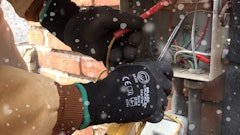
No doubt about it, this summer is turning out to be quite a scorcher in many parts of the country. Whether it’s due to natural causes or climate change can be debated at length. What isn’t up for debate is the need to protect any workers subject to spending long hours in hot conditions.
Safety expert John Meola graciously shared with us his expertise on this topic, providing a plethora of tips to protect both your workforce and your business from the hazards of heat exposure. John is safety manager for the Timmons Group, and an adjunct instructor at Virginia Commonwealth University in Risk Studies, School of Business. He’s spent roughly 30 years in the construction industry and is a recognized authority in industrial safety.
Following are highlights from his recommendations. You can find his full tutorial at www.ForConstructionPros.com/21138091 to access more information — and interesting anecdotes!
1. Get your plan in place
Although OSHA doesn’t have a specific regulation covering heat-related hazards, John says they would likely fall under the general duty clause if you fail to address them in your safety plan. A specific plan identifying and addressing these hazards will help keep you in compliance — and provide a guide to better protect your workforce.
OSHA Reminds Employers of Important Protections for Working Safely in Summer Heat
2. Train supervisors on hazard identification and mitigation
It’s essential that field supervisors know how to identify heat-related hazards and how to implement best practices to protect workers. This includes identifying those employees capable of safely handling certain tasks during high-heat periods and those who may be recognized under OSHA statutes as being at high risk of heat illness. Also provide instruction on requirements for restorative breaks throughout the day in a shaded area and the availability of water or other hydrating beverages at all times .
3. Teach workers to keep their cool
Workers need to be trained in ways they can minimize heat risks, as well. This includes guidance for staying hydrated throughout the work day; recommendations on cooler clothing; tips on the types of food and beverages to avoid; the necessity of taking regular breaks out of the sun, etc.
In addition, all employees should be trained to recognize the signs of heat illness and the steps that must be taken to address them.
4. Provide necessary protective equipment
How you mitigate heat exposure will vary depending on the work site. For example, if a crew is working on top of a hot roof with no shade, it may require use of a canopy or tent. Workers inside a hot building may need cooling fans. Those on a road project may require cooling PPE such as cooling neck bands or bandanas or even cooling vests. In other words, assess the conditions to determine what is most likely to make workers as comfortable as possible and reduce the possibility of heat illness.
As John points out, you can’t control the temperature on jobsites, but you can often engineer a better way to eliminate or reduce many heat-related hazards. Not only will your employees thank you for it, you’ll be less likely get heat from OSHA for failing to take action.




















